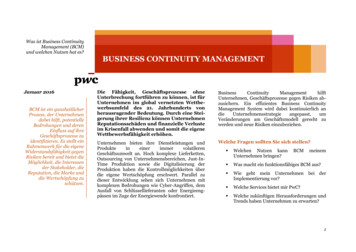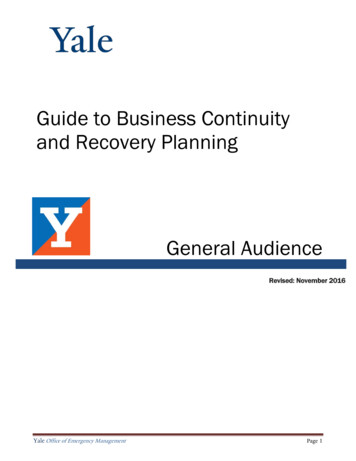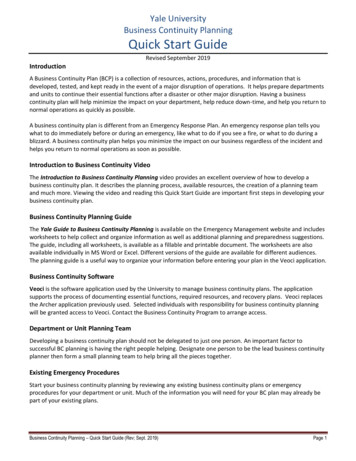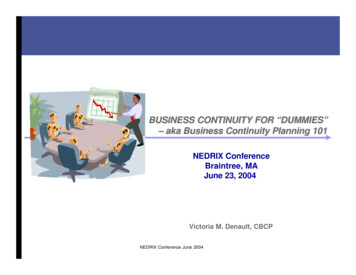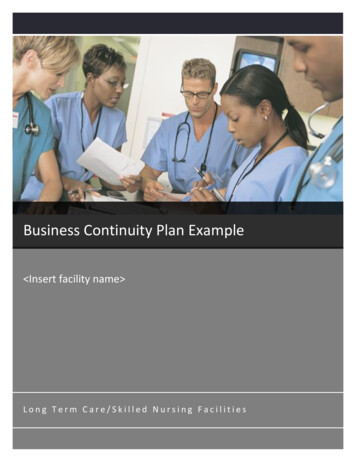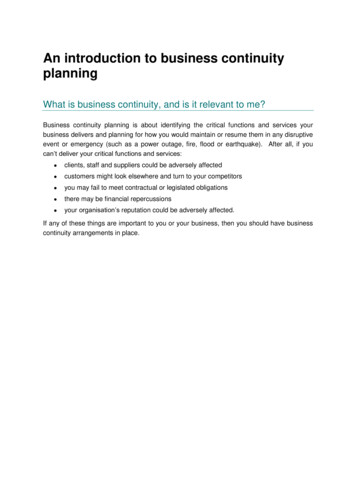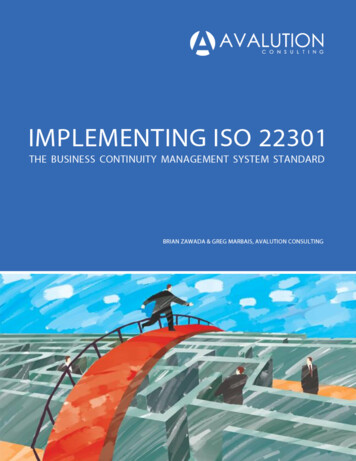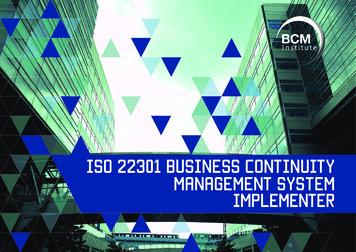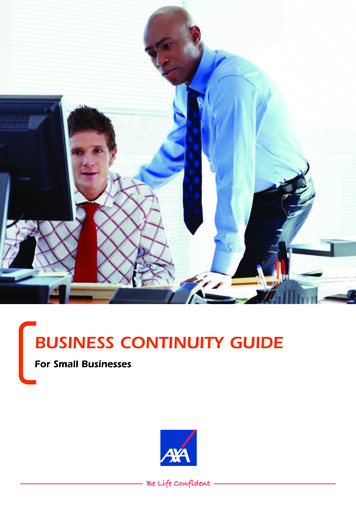
Transcription
BUSINESS CONTINUITY GUIDEFor Small Businesses
CONTENTS Business Continuity Guide for Small BusinessesContents Introduction3 Demystifying Risk Analysis5 Frequently Asked Questions6 Case Study Scenarios8 Successful Business Continuity Planning Sample Business Continuity Plan12221221These documents and any discussion surrounding them (the "Material") are providedwithout responsibility. They are provided on an informal basis for the information only of thenamed intended recipient only (the "Intended Recipient") as an example of howAXA Services Limited ("AXA Services") approaches its own contingency business planning.The Material has been prepared by AXA Services in accordance with its interpretationof contingency business planning practice for its own internal purposes. The Material isconfidential and may not be passed by the Intended Recipient to anyone else.The Intended Recipient is not entitled to rely on the Material, but must take the advice of itsown professional adviser as to the suitability of the Material for the purpose for which it is tobe used. AXA Services cannot accept any responsibility for any loss incurred by theIntended Recipient or any other person arising out of the use of the Material whether suchloss arises by reason of the negligence of AXA Services UK plc or its servants or agents orotherwise howsoever.22
Business Continuity Guide for Small Businesses INTRODUCTIONIntroductionWhether you are a large ‘corporate’ or an SME (Small to MediumSized Enterprise) the ability to respond swiftly and effectively to amajor incident has never been more important.Organisations that have a business continuity capability are far more likelyto survive the effects of a major incident than those that don’t. Two majorincidents in Manchester alone serve to highlight this and the vulnerability ofSME’s. The Manchester city centre bomb in 1996 had a devastating effectwhilst the recent BT tunnel fire, again in Manchester, left many businesseswithout any communications for nearly a week.Think about the effects on your customers and business if your buildingcaught fire. What might the effects be of another fuel crisis, a major utilitiesfailure such as loss of power or the effects of severe weather conditionsincluding floods? What if your neighbours’ building suffered a major fire thatresulted in you having no access to your offices for days, possibly weeks?All of these events could have an impact on the survival of your business. Ifyou’re unable to satisfy your customers’ needs then how confident are you thatthey will wait for you to recover? Sympathy and loyalty will last for only so long.Being prepared is the name of the game. Your plan needn’t be complicatedand doesn’t have to cover every eventuality or every business process, justthose that are most critical.Why wait for something to happen?Steve Mellish FBCI, Vice Chairman, The BusinessContinuity Institutewww.thebci.org3
INTRODUCTION Business Continuity Guide for Small Businesses“As one of the largest insurers of small businesses in the UK,AXA knows all too well the disasters that can affect SMEs –driven by issues ranging from crime, fire and flooding, tocomputer failure and legislation. We have seen first hand thelong-term effect of business disaster – as 80% of businessesaffected by a major incident either never re-open or closewithin 18 months.“It is essential that you have a Business Continuity Plan in placeand your employees are aware of it. A continuity plan fits inwith your business so it need not take a lot of time to complete.We have produced this guide to help you write your owncontinuity plan.Douglas BarnettRisk Control Strategy Manager, AXA4More information onbusiness continuity isavailable on:www.axa4business.co.uk
Business Continuity Guide for Small Businesses DEMYSTIFYING RISK ANALYSISDemystifying Risk AnalysisBusinesses are operating in a world full of risk and uncertainty, yetidentifying and managing risk is still often poorly understood. Mostcompanies will survive if they ensure risk management is central totheir business ethos and updated in line regularly with theirbusiness plan and mission.Businesses are operating in a worldfull of risk and uncertainty, yetidentifying and managing risk is stilloften poorly understood. Mostcompanies will survive if they ensurerisk management is central to theirbusiness ethos and updated in lineregularly with their business plan andmission.Any number of incidents can bringbusinesses grinding to a halt, andsimply getting back up and runningis not where it ends. For this reason,when planning for serious incidentslike fire and flood it is critical to lookbeyond the basics. Effective businesscontinuity planning should look atevery possible impact on thebusiness, from stock losses, impairedtransport and communication links todamaged customer relationships.For small businesses, the impact ofthe potential risks mentioned is likelyto be more destructive as the majorityoperate in specialised markets andany short interruption to normalbusiness can have a disproportionateeffect – totally halting output andletting customers down. In addition,it is more difficult to absorb thefinancial impact of businessinterruption, making it hard to recovereven after returning to normaloperations.AXA understands that many smallbusinesses don’t have easy accessto basic information on businesscontinuity planning.We’ve addressed the most commonlyasked questions on the next page.5
FREQUENTLY ASKED QUESTIONS Business Continuity Guide for Small BusinessesFrequently Asked QuestionsWhat is business continuityplanning?Put simply, business continuity isabout anticipating the crises thatcould affect a firm and planning forthem, to make sure that the businesscan continue to function in the eventof an emergency.What is a business continuityplan?A Business Continuity Plan sets outclear roles and responsibilities, forexample those assigned to manageall liaison with customers, employeesand the emergency services. It listsa series of contingencies that enablekey business activities to continue inthe most difficult circumstances, suchas when a vital computer system orother equipment is unavailable.Importantly, it also details clearemergency procedures to ensurethat the safety of employees is a toppriority.Because it requires an assessment ofall critical areas of a firm, businesscontinuity planning is a valuablemanagement tool.Why should small firms care aboutbusiness continuity planning?Business success is as much aboutprotection as growth. In an uncertainworld, that means creating a businesswith the flexibility to prosper in6changing conditions and strongenough to survive should a disasterstrike. The ability to withstand seriousincidents like flooding and fire, andquickly re-open for ‘business as usual’is critical. There is also thecommercial benefit to consider, ascompanies with business continuityplans are more attractive to dobusiness with. For example, largebusinesses that rely on theoutsourced services of third partieswill prefer to work with suppliers whohave a Business Continuity Plan inplace.How does business continuityplanning differ from a disasterrecovery plan?Disaster recovery plans traditionallyfocus on the IT recovery of thebusiness such as tape backupsystems, storage systems, and hotsites.A Business Continuity Plan willaddress all the requirements essentialto keeping the business running andincludes processes to keep disruptionto customers and employees toa minimum. In short, it is aboutensuring that a crisis is managedeffectively before it escalates to adisaster.
Business Continuity Guide for Small Businesses FREQUENTLY ASKED QUESTIONSIsn’t my business too small to havea business continuity planin place?Protecting the future of a businesswhatever the size has to be thenumber one priority for everybusiness leader. The smaller yourbusiness the more important it is tohave a contingency plan in place. Anyincident, no matter how small iscapable of impacting your businessand profitability. The size of anycontinuity plan will depend on therisks facing each business – it will beas large or small as needed.Doesn’t it cost a lot of money toimplement continuity planning?It does not need to be a costlyexercise. The continuity plan will fityour business as it accounts for yourkey risks and outlines how yourcompany will manage them. Planningfor the future is essential in anybusiness, the price of not doing socould be a lot higher than manycompanies anticipate.Later in the guide there is an exampleof a Business Continuity Plan for youto refer to when drafting your own.7
CASE STUDY SCENARIOS Business Continuity Guide for Small BusinessesCase Study ScenariosPutting Business Continuity Planning into ContextThe first step in creating a sensible business continuity process isto consider the impacts of any potential disaster and the effect ofeach on your business – this is critical if you are to plan properly. Ifyou have little idea of the likely impact on your organisation then itis impossible to be prepared. Below are a series of scenarios andhypothetical situations to give you an idea of what can go wrong ifyou do not have a plan in place.1. Sector: RetailRisk: Telecom/IT FailureCompany A is a busy independenttravel agency relying on telephoneand IT systems to provide itscustomers with the same service asthe major travel groups. In Januarylast year, a key trading period fortravel agents, the telephone and ITsystems failed due to a power cut.The council was resurfacing a roadnear the premises and cut through apower supply cable affecting one sideof the high street for three days.Company A relies on phone and ITsystems to confirm prices, checkavailability of holidays and flights andcomplete currency exchangetransactions for its customers.As a result, the travel agency lostconsiderable business to competitoragencies including one contract fora business account with a largemanufacturing business in the town.Customer loyalty and repeat businessare very important in what is now an8extremely competitive business.Company A suffered from negativecustomer experiences and lost itsmost profitable customer.Douglas BarnettRisk Control strategy Manager,AXAThis is a classic example of not beingprepared and thinking that ‘it won’thappen to me’. This scenario showshow planning before an event canallow a business to react quickly tointerruption. Having the foresight todiscuss reciprocal agreements withother independent travel agencieswould have allowed for staff to utilisetheir mobile phones to checkavailability of flights/holidays andprocess bookings through thealternative agency in the short period.Company A was lucky that this wasnot a long-term disaster, and thatpower was restored after a few days.Had it been a fire or flood thebusiness may have lost considerablymore customers. The travel company
Business Continuity Guide for Small Businesses CASE STUDY SCENARIOSdid suffer seriously from its reputationbeing damaged and this might neverbe restored. If company A hadthe foresight to make reciprocalarrangements with local travel agentsits key customers could havecontinued to make bookings andpassing trade would not have beenlost to the national travel chains.A disaster can happen to anycompany, big or small, and it isimportant to be prepared for everyeventuality.2. Sector: ManufacturingRisk: Fire & key equipmentfailureFifteen years ago a food-processingcompany was ravaged by fire, but theowners were lucky enough to be ableto rebuild and start again. Thebusiness went on to tradesuccessfully for many years in atraditional brick building. Changes inenvironmental health regulationsforced the company to improve itsprocess and storage areas. Theguidelines stated that the businessneeded to create a ‘food safe’structure within the factory, by usinginsulated sandwich panels. Thesandwich panels comprised of twothin sheets of metal with a coreconsisting of a combustible insulationmaterial – to form rooms within theoriginal building. A few weeks later, acontractor was employed to fit asafety handrail to an elevatedplatform. While welding, sparksignited in the combustible core of asandwich panel adjacent to the workarea. The fire spread rapidly throughthe combustible insulation within thepanels, causing the internal structureto collapse and the building wascompletely destroyed. This time, theowners lost a major retail customerand the business never reopened.Douglas BarnettRisk Control Strategy Manager,AXAThe alterations to meet revisedenvironmental health requirementschanged the physical structure ofthe factory considerably. The ownersmade one very large and fatal error –they forgot to align their riskassessment intelligence with thenewly built factory. The risks facedby a business are transformed asthe business changes. Every time youupdate your business or premises,make sure your plans and processesreflect these changes. For example,consult with insurers whenundertaking structural changes toyour business premises – they maybe able to assist in the specificationof appropriate materials that in thelong term will protect the businessand control premium levels.Understand and control the risksposed to your business by third partycontractors – hot-work permits can beused to control contractors. Reevaluate your overall risks regularly9
CASE STUDY SCENARIOS Business Continuity Guide for Small Businessesto ensure you stay one step ahead at all times.3. Sector: Service (Sales Industry)Problem: Unable to access business premisesCompany X is a market research firm that relies on itstelephone systems to conduct business and communicatewith clients. On a day-to-day basis employees are constantlyon the telephone conducting market research surveys to fulfilclient requirements. In October 2003 a fire broke out in thebuilding next door to Company X on the industrial estatewhere it is based. The fire caused considerable damage tothe adjacent building and because of the fire br
What is business continuity planning? Put simply, business continuity is about anticipating the crises that could affect a firm and planning for them, to make sure that the business can continue to function in the event of an emergency. What is a business continuity plan? A Business Continuity Plan sets out clear roles and responsibilities, for
